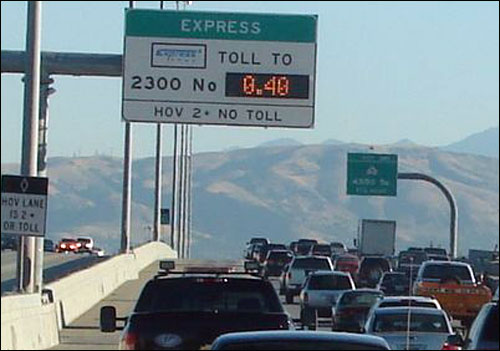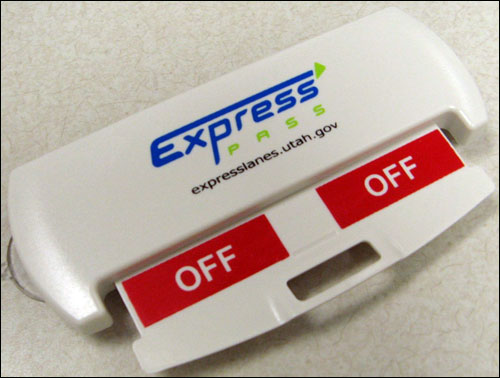Oct 01, 2010After utilizing a prepaid windshield stickers to move more commuters through the express lanes on Interstate Highway 15, the Utah Department of Transportation (UDOT) launched an electronic toll-collection system this summer that it says is a first in the United States to use EPC Gen 2 passive ultrahigh-frequency (UHF) RFID tags. The tags transmit their ID numbers to readers located 20 feet or more away from vehicles traveling at a speed of 55 miles per hour or more.
The system went live one month ago, and UDOT has sold 7,200 transponders to date. Since then, the agency reports, traffic has improved through the more congested areas of Salt Lake City. Users are attaching the transponders to their vehicle windshields, and readers mounted above the highway are capturing those tags' ID numbers, enabling UDOT to charge each driver a varying amount of money based on the zone in which he or she drives, as well as the time of day and the amount of traffic present at that time.
The express lane on I-15 (which runs north-south through Salt Lake City) was first provided for high-occupancy vehicles at the time of the 2002 Winter Olympics, says Catherine Cutler, UDOT's express lanes program manager. The agency had created 38 miles of contiguous HOV lane by 2006, and began looking into phasing in a toll program that would help ease traffic during peak hours. At that time, it began selling stickers, priced at $50 per month, that commuters could apply to their windshields and thereby access the express lanes that had previously been dedicated only for high-occupancy vehicles. Those stickers did not employ RFID technology, and instead used text and colored ink to identify a particular car as being entitled to use the HOV lane even if its driver had no other passengers in the vehicle. Approximately 1,600 customers participated in the sticker program. "We had good success with it," Cutler says, "and decided to move forward into an electronic program."
Engineering firm PBS&J served as project manager for the electronic toll-collection system, worked with UDOT to identify an automated toll-collection system that utilizes passive UHF RFID technology, says Julie Dillard, PBS&J's consultant project manager for the express lanes project. PBS&J and UDOT picked electronic toll-collection system provider TransCore—which contributed the system's readers, as well as the software that receives and interprets data for tag reads—to set up an infrastructure of highway readers.
The agency wanted inexpensive tags, so a passive UHF tag model was deemed a cheaper alternative to the battery-powered transponders used by many other highway agencies around the world. However, the agency also sought a tag that could be turned on and off, thereby allowing a commuter to disable his or her tag in the event that a passenger is in the vehicle (in which case the driver need not pay a fee when using the express lane). Although TransCore does offer a such a passive UHF tag, based on the ISO 18000-6b standard, , the tag included many other features in addition to switching on and off, making it a costlier choice than a simple tag containing only an on-off switch.
Although UHF EPC Gen 2 passive RFID tags have been used for toll collection in other countries (see RFID News Roundup: Uruguay Deploys RFID-enabled Toll System), this application is a first in the United States, Dillard says. This system, she adds, demonstrates that EPC Gen 2 tags can transmit at distances of 30 feet or more at high speeds without the use of a battery, with the proper antenna array within the tag.

Utah commuters can use or disable tags when they so choose, and then have funds automatically deducted from a prepaid account when the enabled tags are read on the highway. There are four zones currently using the system along the highway, in the state's Utah and Salt Lake City counties. Altogether, 30 TransCore readers have been installed above the express lane on overhead signage indicating the current price for traveling in the express lanes—prices vary from 25 cents to $1 for each zone (depending on the amount of traffic congestion on the highway), equaling a total of up to $4 for one 50-mile commute through all four zones in one direction.
To participate in the Express Lanes electronic payment program, a driver must first order an Express Pass transponder, either online or by using a call center managed by Electronic Transaction Consultants Corp. (ETC), a Texas-based provider of toll-collection solutions and services. That individual makes a payment of $8.75 for the transponder itself, and then sets up an account with a credit or debit card with a prepaid balance of $25 that automatically renews if the balance drops below $10. ETC then mails the customer a transponder encoded with a unique ID number linked to that person's account, which is managed by ETC under contract to UDOT.
A total of 37 electronic signs indicating the cost of driving in the express lane have been installed on overhead gantries at various points along the highway. Seven such signs are installed above ramps, or act only as advanced alerts, and thus lack RFID readers. For each of the 30 other signs, a reader with a single antenna is mounted on the same gantry as the sign. If a driver enters the lane, the interrogator captures the ID number encoded to his or her vehicle's transponder. The reader transmits that data, via a cabled connection, to TransCore software that calculates the charge (based on the traffic congestion and the number of zones through which the vehicle drives while in the express lane) and sends that information, along with the ID number, to ETC, which then deducts the charge from the individual's account. In the TransCore software, the tag ID is not linked to that person's name or any specific vehicle, but once the read data is forwarded to the ETC software, the ID number is used to access account information (including the user's account number and name) to deduct the appropriate toll from that account.
If there is another passenger in the vehicle, the driver simply pulls the tab out, which disables the tag, and he or she can then drive through the express lanes without being charged.
In the month since the system's installation, Cutler says, traffic has moved more efficiently through the non-express lanes. In 2012, the agency hopes to add 24 miles of the electronic express lanes in Utah County, directly south of Salt Lake City County. Before deploying the RFID toll system, she says, the express lanes often had few vehicles on them, while the other lanes slowed due to heavy congestion.
Thus far, with 7,200 transponders sold, the agency has noticed an effect on the highway's non-express lanes due to an easing of traffic. The electronic system may be more popular, Cutler suggests, because it charges drivers per usage rather than an upfront monthly fee, as it did for the stickers. During the four weeks during which the RFID system has been in operation, she notes, the number of uses by customers has increased, signaling they may be getting more comfortable with the system. "It's working exactly the way we wanted it to," she says. "We expect the customer base to grow as we gain more customer confidence."




